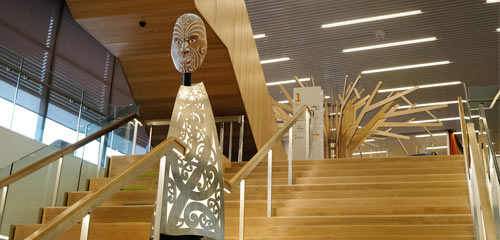The Matapopore Trust has been a key partner in the development of our new central library since the beginning of the project. Cultural values, aspirations and narratives are woven throughout Tūranga's entire experience.Tūranga is a name that carries with it considerable responsibility. Tūranga speaks of whakapapa across generations, connections to the north and out to Te Moana-nui-a-Kiwa and the wider Pacific. Recounted in the waiata ‘E Tuku Ana’, Tūranga is celebrated in a depiction on the west-facing outer wall of the library building.
Integrating Mātauranga mana whenua
The Ngāi Tūāhuriri influence on the design and build of Tūranga is centred on the notion of mātauranga mana whenua – the body of knowledge that originates from the people of this place.
Key cultural values, aspirations and narratives were woven holistically into the conceptual development of the architecture and spatial experience of Tūranga. The inclusion of integrated design and artworks that translate traditional mātauranga into contemporary form adds a rich and dynamic layer to the experience of place.
Watch a video, Ngā Toi o Tūranga, in which Matapopore representatives and the artists discuss the artworks and their cultural context.
Audio tour
Listen to an audio tour of Tūranga about the building's cultural narrative with Joseph Hullen, Matapopore trustee.
Find your way in Tūranga
The Artworks
Rau Whakapapa
Waruwarutū – Ngā Pounamu Māori collection, Tuakiri | Identity, Level 2
Ranui Ngarimu and Areta Wilkinson
Listen to the name of this artwork [MP3]

‘Rau Whakapapa’ is an installation of harakeke (New Zealand flax, Phormium tenax) that elevates the significance of this natural resource including cultural values, material knowledge and technologies. Looking closely, the netted structure of the harakeke fibre is an emblem of relational connections where cultural knowledge is linked and passed on.
Sited in a wall mounted lightbox the artwork is a welcoming beacon that is orientated towards entrance routes, exhibition rooms and information kiosks to draw visitors into ‘Waruwarutū’ – the Ngā Pounamu Māori Collection.
The artists prepared components from the harakeke leaf sections, stripped leaves to produce the whītau fibres, and dried the natural materials to remove moisture. The experience was a collaborative one shared with Tūranga staff and the Tūranga Architects/design team to increase their mātauranga Māori knowledge and as an opportunity to contribute to the artwork production. Other helpers processed materials or collected the shells to use for fastening.
Kākano Puananī – Airborne Seeds
Tautoru, TSB Space, Hapori | Community, Level 1
Riki Manuel and Morgan Mathews-Hale
Listen to the name of this artwork [MP3]
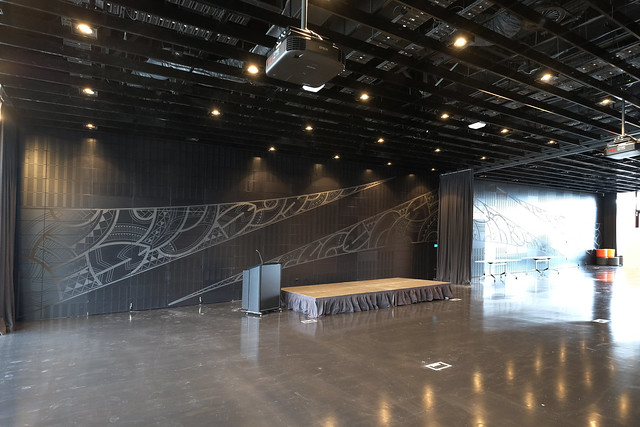
‘Kākano Puananī’ tells the Ngāi Tahu creation story in a series of panels.
From the union of Ranginui and his first wife Pokoharuatepō, came their sons, Aoraki/Mt Cook, Rakiroa/Mount Dampier, Rakirua/Mount Teichelmann, Rarakiroa/Mount Tasman. The work also shows their overturned waka commonly known as our Southern Alps or Ngā Tiritiri-o-te-Moana.
Tū-te-raki-whanoa was the demi-god who carved valleys and rivers through Te Waipounamu/South Island. Tū-te-raki-whanoa broke the side of the waka of Aoraki with his thigh, releasing the water and creating the flow through the Māwhera/Grey river to the West Coast.
Tāwhirimātea, the Māori wind deity, dispersed the kākano puananī/seeds through the air, represented by the perforated shapes surrounding the maunga.
Mātauranga – The Ascent of Tāwhaki
All levels – lift surrounds and ground-floor reception area
Morgan Mathews-Hale
Listen to the name of this artwork [MP3]
‘Mātauranga – The Ascent of Tāwhaki’ features around the lift exteriors and reception area of Tūranga. The installation uses imagery relating to the journey of Tāwhaki through the heavens to obtain knowledge or Mātauranga.
Ngāi Tahu narratives tell of tukutuku pūngāwerewere/spider’s web which Tāwhaki climbed, represented in the Ascent of Tāwhaki by the carving pattern pūngāwerewere.
The Manu theme in reception relates to the Manu that appear in the lift surrounds. They are flying towards, or on, a journey to discovery. Searching or looking into the unknown, much like the manuhiri to the Library. The colours are relative to the journey between the ground floor (green) and the top floor (blue) indicating the journey through the library floors. They also pay tribute to Muriwai, the pool of water where Tāwhaki obtained his stones of knowledge.
He Hononga | Connection, Ground Level
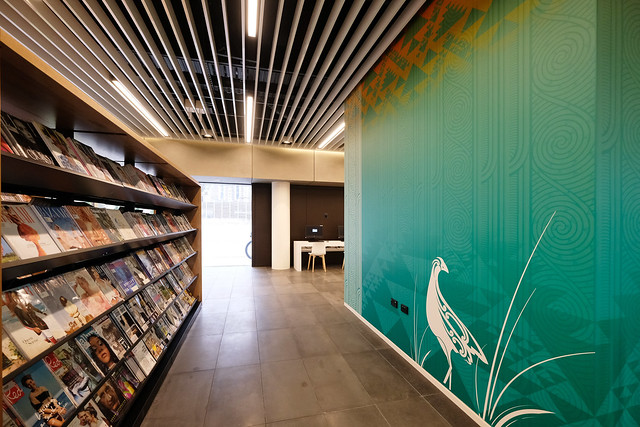
The Pākura were prolific amongst the swampy waterways and low-lying areas. Pākura or Pūkeko were gathered and harvested as a food source. The feathers were used for various adornments including cloaks but were not so highly prized as they were relatively easy to capture with snare traps. Mature seeds of the swampy grasslands including patiti and wiwi were food crops of the pākura as well as small creatures and insects.
Hapori | Community, Level 1
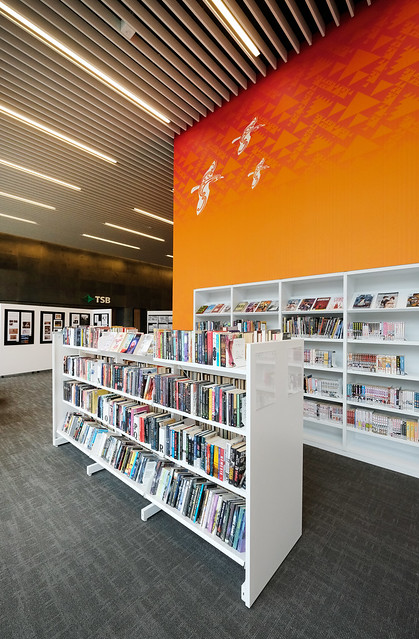
The Tītī were common along coastal areas and would nest in rocky landscapes to breed and provide safety for young chicks to grow and develop before leaving the nest. The birds were culled and harvested and preserved in pōhā, to be used when food sources were out of season. Trade was another form of distributing the localised foods in exchange for resources sourced from other areas of the motu/island.
Tuakiri | Identity, Level 2
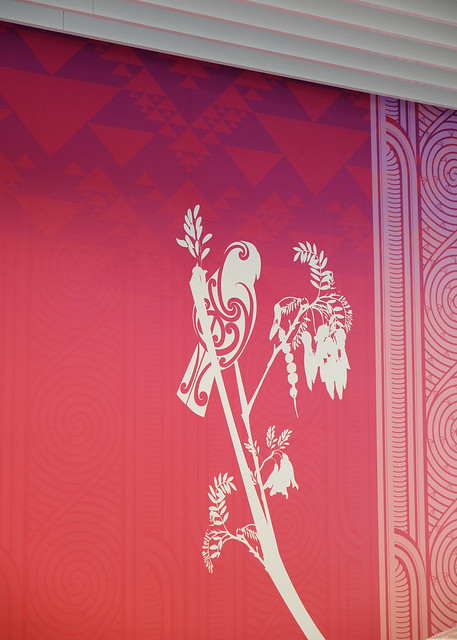
The Kākāpō feathers of the large flightless parrot, were used to adorn the feathered cloaks of rangatira as the feathers shimmered against the light with hues of gold. The birds were also prized as a food source and again the process to render the fat from the bird was often carried out. The tīpuna /ancestors and chiefs laid claimed to the kākā and the lands in which the bird nestled. Some landscapes with rocky caves and coves were common for the bird to occupy, however introduced species of rodents killed many of the birds and we no longer have these birds in abundance.
Tūhuratanga | Discovery, Level 3
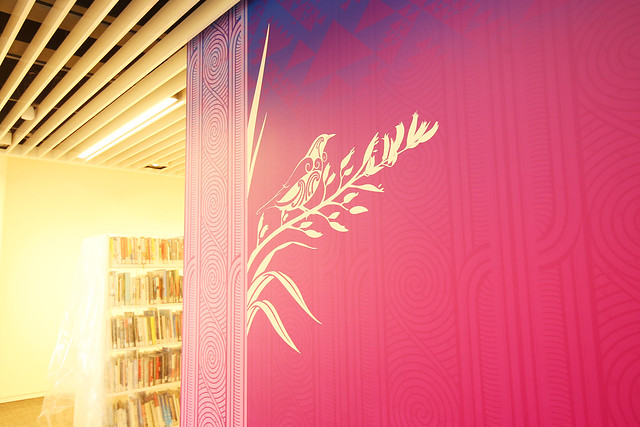
The Tūī were prized for their iridescent feathers to adorn kākahu /cloaks. Over thirty bird carcasses would be required to make one cloak. The feathers from the korokoro of the tūī were treasured and given as plumes to be worn by the rangatira /chiefs. The birds were also trained to recite different words, waiata/song and rangi/tunes and were kept in cages for rangatira entertainment.
The carcasses were also a favourite food supplement and would be preserved in bull kelp bags known as pōhā. The feathers would be fastened to the bag, so people knew what was inside. Tūī were given as koha and used for various exchange and trade. Tūī relied on the sweet nectars of many of the flowers of plants including kōwhai, ngutu kākā and harakeke and wharariki.
Auahatanga | Creativity, Level 4
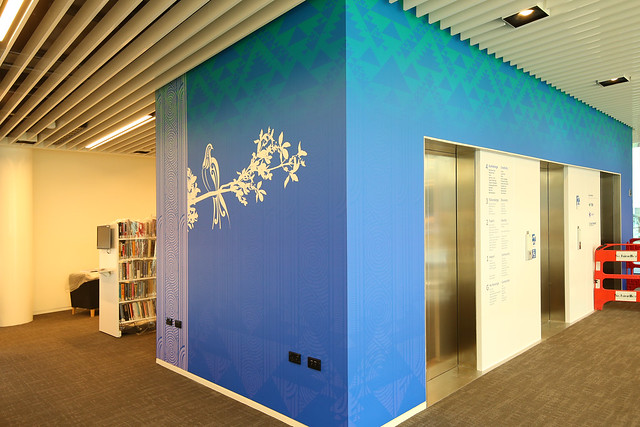
The Kūkupa feathers were used for adorning kahu kūkupa/feathered cloaks. The white plumes were used to dress various weapons including tewhatewha as the radiance of the green and deeper hues from the head and neck. The birds were ideal to render the fat over a gentle flame which was collected in a kumete/wooden bowl. This was then used for various purposes including mixing with other juice extracted from plants to flavour the bitter food sources of aruhe/bracken fern. Aruhe were the most staple fibrous resource available in many areas and families and members of the tribe often protected these food stands.
Tūhura
External west-facing basalt wall on Colombo Street
Morgan Mathews-Hale and Riki Manuel
Listen to the name of this artwork [MP3]
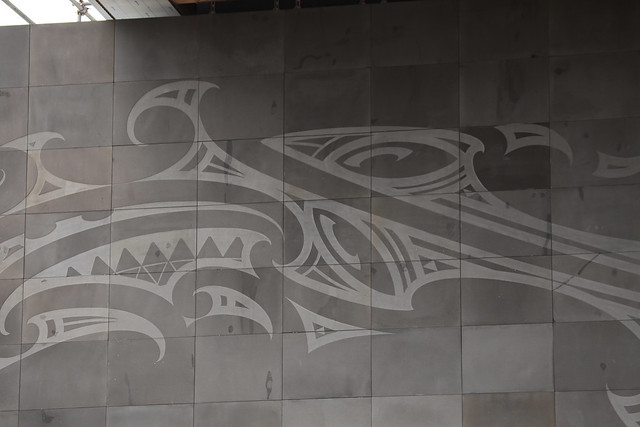
The external wall captures the significance of Ngāi Tahu whakapapa and celebrates migration and voyaging of generations from Hawaiki to Te Wai Pounamu. This marks the beginning of human migration and can be applied to tangata katoa around the world.
Watch video 'The meaning behind Tūranga's tile motif' in which the artists talk about the themes of the artwork.
Tāwhaki
Ngā Iho o te Rangi (the name of the atrium stairway)
Fayne Robinson, assisted by his nephew Caleb Robinson
Listen to the name of this artwork [MP3]
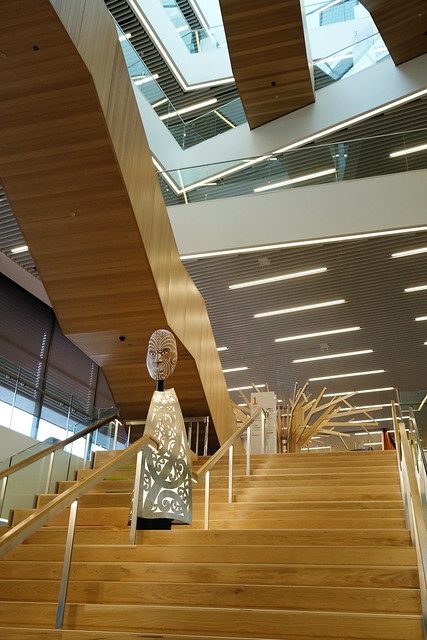
This figure sits on a landing on the flight of stairs to the First Floor of Tūranga. The brief for this sculpture is a depiction of Tāwhaki and his journey in search of knowledge. In Ngā Pikitūroa o Ngāi Tahu: The Oral Traditions of Ngāi Tahu, Dr Tau applies ‘Te Kawa a Tāwhaki’ to prepare the reader for a different kind of history.
He states:
“The myth of Tāwhaki established the structural framework in which knowledge is retained and transmitted. Because Tāwhaki sought, returned with and established the core principles of knowledge and whakapapa… Tohunga who held tribal traditions modelled themselves on Tāwhaki. It was this group who compiled the oral traditions of Ngāi Tahu into written form last century.” (Tau, 2003, p.15-16).
The materials used for this sculpture are a combination of steel, tōtara, and the use of light visible through the traditional kōwhaiwhai patterns, capturing the story of Tāwhaki as he ascends to the heavens above.
Kāhui Whatu
Ngā Iho o te Rangi (the name of the atrium stairway) He Hononga | Connection, Ground Level
Fayne Robinson
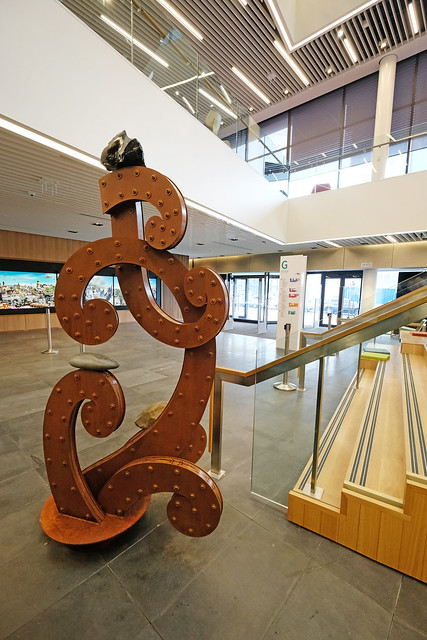
This plinth is created from a combination of mild steel and plywood in kōwhaiwhai form, housing three different types of rock, and is an acknowledgement of their importance to early Māori society, as they were used extensively prior to the discovery of pounamu. These rocks support the installation, ‘Te Kāhui Whatu’ being the stones that lay in the bottom of the pool 'Muriwai'.
Dual language signage and naming
A dual language approach to signage and naming was adopted for Tūranga. Mana whenua language preferences have been included throughout in bilingual wayfinding signage and in the naming of key spaces. The naming of this building ‘Tūranga’ is testament to this commitment.
Summary
The creative works and installations included in Tūranga draw firmly from Ngāi Tūāhuriri and Ngāi Tahu mana whenua traditions. It was important that these cultural elements provide pathways to greater learning, secure traditional knowledge, and build collective memory in new forms and formats. Mātauranga has been integrated into the architectural and spatial resolution of Tūranga as a distinct, visible presence that draws from traditions specific to this place and its people. Through an ongoing collaborative process, mātauranga mana whenua has been combined seamlessly within the library.
Tūranga is a unique bicultural interpretation of a ‘storehouse of knowledge’.
List of artworks and credits
External
Tūhura by Morgan Mathews-Hale and Riki Manuel
All levels
Mātauranga – The Ascent of Tāwhaki by Morgan Mathews-Hale
He Hononga | Connection, Ground Level
Kāhui Whatu by Fayne Robinson
Tāwhaki by Fayne Robinson, assisted by his nephew Caleb Robinson
Hapori | Community, Level 1
Kākano Puananī – Airborne Seeds by Riki Manuel and Morgan Mathews-Hale
Tuakiri | Identity, Level 2
Rau Whakapapa by Ranui Ngarimu and Areta Wilkinson
Related pages
- Tūranga - about our name
- Matapopore Tūranga project sheet
- Listen to an audio tour of Tūranga about the building's cultural narrative with Joseph Hullen, Matapopore trustee.
- Māori name pronunciation sound files
- Pūawaitanga o te ringa - Tukutuku panel art at Tūranga
- City of Christchurch - Ngāi Tahu: Historical Note
- Tūranga exhibitions

